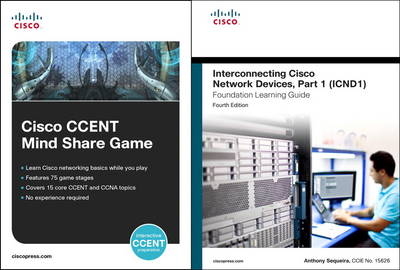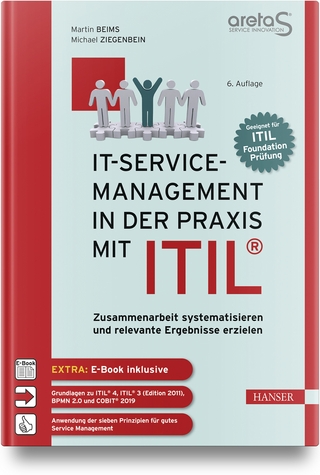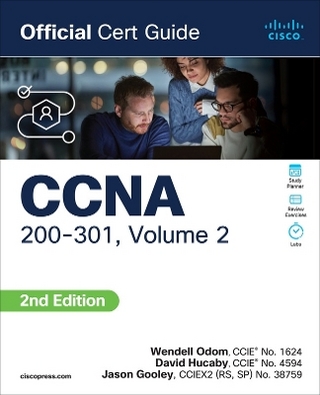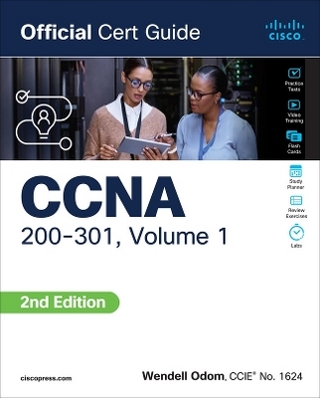
Cisco CCENT Mind Share Game and Interconnecting Cisco Network Devices, Part 1 (ICND1) Bundle
Cisco Press (Verlag)
978-1-58714-417-2 (ISBN)
- Titel ist leider vergriffen;
keine Neuauflage - Artikel merken
Learn CCENT Networking Basics While You Play
15 levels of interactive, hands-on training for Cisco networking basics plus a best-selling ICND1 study guide in one value priced bundle!
Includes:
A world-class learning game featuring 75 game stages and covering 15 core CCENT/CCNA topics
The official foundation learning guide from Cisco providing comprehensive ICND1 100-101 exam topic coverage
“We worked with the best serious game developers, educators, and technical experts to produce a game that is not only fun, but will help you learn.”
–Jerry Bush, Mind Share Game Project Lead, Cisco
This package lets you test your technical knowledge as well as your ability to perform under pressure in a stimulating PC game setting plus it provides deeper insights from the official Cisco foundation learning guide.
The game features 75 game stages across 15 topic areas. Interactive tutorials supplement game play and help reinforce concepts being taught in each round. The book provides you with the knowledge needed to configure Cisco switches and routers to operate in corporate internetworks. CD-ROM contains: Cisco CCENT Mind Share Game and four additional networking games: Binary Game, Subnetting Game, Wireless Explorer, and an offline version of Multiplayer Challenge.
Mind Share Game Minimum System Requirements:
Windows XP SP2, Windows Vista, Windows 7
100 MB disc space for required install
1.7 GHz-equivalent processor
256 MB RAM
256 MB VRAM
256 MB graphics card
Sound card
Connection to the Internet during installation for access code validation
Learning@Cisco creates and offers educational products, certifications, communities and consulting services that address the global networking skills talent gap. Through education and expertise, Learning@Cisco drives the talent development needed to evolve the workforce of today to meet the demands of tomorrow, and the global networking skills talent gap. For more information about Learning@Cisco, go to http://www.ciscolearningnetwork.com. Anthony Sequeira, CCIE No. 15626, is a seasoned trainer and author regarding all levels and tracks of Cisco certification. Anthony formally began his career in the information technology industry in 1994 with IBM in Tampa, Florida. He quickly formed his own computer consultancy, Computer Solutions, and then discovered his true passion–teaching and writing about Microsoft and Cisco technologies. Anthony joined Mastering Computers in 1996 and lectured to massive audiences around the world about the latest in computer technologies. Mastering Computers became the revolutionary online training company, KnowledgeNet, and Anthony trained there for many years. Anthony is currently pursuing his second CCIE in the area of security and then his third Cisco Data Center! When not writing for Cisco Press, Anthony is a full-time instructor for the next-generation of KnowledgeNet, StormWind.com.
Cisco CCENT Mind Share Game:
1. Devices and Cables
2. OSI Model
3. Binary Numbers
4. MAC Addressing
5. Switch Basics
6. Switch Behavior
7. IP Addressing
8. Routing Protocols
9. Routing: ARP
10. Routing NAT/PAT
11. Protocols
12. Subnetting
13. Cisco IOS
14. Wireless
15. The Greatest Bits
Interconnecting Cisco Network Devices, Part 1 (ICND1) Foundation Learning Guide:
Chapter 1 The Functions of Networking 1
Chapter Objectives 2
What Is a Network? 2
Physical Components of a Network 4
Interpreting a Network Diagram 5
Network User Applications 7
Impact of User Applications on the Network 8
Characteristics of a Network 10
Physical Versus Logical Topologies 11
Physical Topologies 11
Logical Topologies 12
Bus Topology 13
Star and Extended-Star Topologies 14
Star Topology 14
Extended-Star Topology 15
Ring Topologies 16
Single-Ring Topology 16
Dual-Ring Topology 17
Mesh and Partial-Mesh Topologies 17
Full-Mesh Topology 17
Partial-Mesh Topology 18
Connections to the Internet 18
Chapter 2 The OSI and TCP/IP Models 25
Chapter Objectives 26
Understanding the Host-to-Host Communications Model 26
The OSI Reference Model 27
Layer 7: The Application Layer 29
Layer 6: The Presentation Layer 29
Layer 5: The Session Layer 29
Layer 4: The Transport Layer 30
Layer 3: The Network Layer 30
Layer 2: The Data Link Layer 31
Layer 1: The Physical Layer 31
The Data Communications Process 31
Encapsulation 32
Deencapsulation 33
Peer-to-Peer Communication 34
The TCP/IP Protocol Stack 35
OSI Model Versus TCP/IP Stack 36
Chapter 3 LANs and Ethernet 43
Chapter Objectives 44
Understanding LANs 44
The Definition of a LAN 44
Components of a LAN 45
Functions of a LAN 46
How Big Is a LAN? 47
Ethernet 48
Ethernet LAN Standards 48
LLC Sublayer 49
MAC Sublayer 49
The Role of CSMA/CD in Ethernet 49
Ethernet Frames 50
Ethernet Frame Addressing 52
Ethernet Addresses 52
MAC Addresses and Binary-Hexadecimal Numbers 53
Connecting to an Ethernet LAN 54
Ethernet Network Interface Cards 54
Ethernet Media and Connection Requirements 55
Connection Media 55
Unshielded Twisted-Pair Cable 57
UTP Implementation 58
Auto-MDIX 62
Optical Fiber 62
Chapter 4 Operating Cisco IOS Software 69
Chapter Objectives 70
Cisco IOS Software Features and Functions 70
Cisco IOS CLI Functions 71
Configuring Network Devices 72
External Configuration Sources 73
Entering the EXEC Modes 75
Help in the CLI 77
Enhanced Editing Commands 79
Command History 81
Managing Cisco IOS Configuration 81
Improving the User Experience in the CLI 84
Chapter 5 Switch Technologies 89
Chapter Objectives 90
The Need for Switches 90
Switch Characteristics 92
Starting and Configuring a Switch 93
Switch Installation 93
Switch LED Indicators 93
Connecting to the Console Port 94
Basic Switch Configuration 95
Verifying the Switch Initial Startup Status 97
Switching Operation 99
Duplex Communication 100
Troubleshooting Common Switch Media Issues 102
Media Issues 102
Port Issues 106
Chapter 6 VLANs and Trunks 111
Chapter Objectives 112
Implementing VLANs and Trunks 112
Issues in a Poorly Designed Network 112
VLAN Overview 114
Understanding Trunking with 802.1Q 115
802.1Q Frame 116
802.1Q Native VLAN 117
Understanding VLAN Trunking Protocol 118
VTP Modes 118
VTP Operation 119
VTP Pruning 120
Configuring VLANs and Trunks 121
VTP Configuration 122
Example: VTP Configuration 122
802.1Q Trunking Configuration 123
VLAN Creation 126
VLAN Port Assignment 128
Adds, Moves, and Changes for VLANs 129
Adding VLANs and Port Membership 129
Changing VLANs and Port Membership 130
Deleting VLANs and Port Membership 130
VLAN Design Considerations 130
Physical Redundancy in a LAN 131
Routing Between VLANs 133
Understanding Inter-VLAN Routing 133
Example: Router on a Stick 134
Example: Subinterfaces 135
Configuring Inter-VLAN Routing Using Router on a Stick 135
Using Multilayer (Layer 3) Switches 136
Chapter 7 The TCP/IP Internet Layer 139
Chapter Objectives 140
Understanding TCP/IP’s Internet Layer 140
IP Network Addressing 140
IP Address Classes 143
Network and Broadcast Addresses 145
Public and Private IP Addresses 149
Address Exhaustion 150
Addressing Services 153
Dynamic Host Configuration Protocol 154
Domain Name System 155
Using Common Host Tools to Determine the IP Address of a Host 155
Chapter 8 IP Addressing and Subnets 161
Chapter Objectives 161
Understanding Binary Numbering 162
Decimal and Binary Systems 162
Least Significant Bit and Most Significant Bit 163
Base 2 Conversion System 164
Powers of 2 164
Decimal-to-Binary Conversion 165
Binary-to-Decimal Conversion 166
Constructing a Network Addressing Scheme 167
Subnetworks 167
Two-Level and Three-Level Addresses 169
Subnet Creation 170
Computing Usable Subnetworks and Hosts 170
Computing Hosts for a Class C Subnetwork 170
Computing Hosts for a Class B Subnetwork 171
Computing Hosts for a Class A Subnetwork 172
How End Systems Use Subnet Masks 173
How Routers Use Subnet Masks 174
Mechanics of Subnet Mask Operation 176
Applying Subnet Mask Operation 178
Determining the Network Addressing Scheme 179
Class C Example 180
Class B Example 181
Class A Example 183
Implementing Variable-Length Subnet Masks 184
Introducing VLSMs 184
Route Summarization with VLSM 187
Chapter 9 The TCP/IP Transport Layer 195
Chapter Objectives 195
Understanding TCP/IP’s Transport Layer 196
The Transport Layer 196
TCP/IP Applications 199
Transport Layer Functionality 200
TCP/UDP Header Format 202
How TCP and UDP Use Port Numbers 204
Establishing a TCP Connection: The Three-Way Handshake 205
Session Multiplexing 208
Segmentation 209
Flow Control for TCP/UDP 209
Acknowledgment 210
Windowing 211
Fixed Windowing 211
Example: Throwing a Ball 212
TCP Sliding Windowing 213
Maximize Throughput 214
Global Synchronization 214
Chapter 10 The Functions of Routing 219
Chapter Objectives 220
Exploring the Functions of Routing 220
Routers 220
Path Determination 222
Routing Tables 223
Routing Table Information 223
Routing Update Messages 224
Static, Dynamic, Directly Connected, and Default Routes 224
Dynamic Routing Protocols 225
Routing Metrics 225
Routing Methods 226
Chapter 11 The Packet Delivery Process 233
Chapter Objectives 233
Exploring the Packet Delivery Process 234
Layer 1 Devices and Their Functions 234
Layer 2 Devices and Their Functions 234
Layer 2 Addressing 235
Layer 3 Devices and Their Functions 236
Layer 3 Addressing 236
Mapping Layer 2 Addressing to Layer 3 Addressing 237
ARP Table 238
Host-to-Host Packet Delivery 238
Function of the Default Gateway 247
Using Common Host Tools to Determine the Path Between Two Hosts Across a Network 248
Chapter 12 Configuring a Cisco Router 255
Chapter Objectives 255
Starting a Cisco Router 256
Initial Startup of a Cisco Router 256
Initial Setup of a Cisco Router 257
Logging In to the Cisco Router 263
Showing the Router Initial Startup Status 266
Summary of Starting a Cisco Router 267
Configuring a Cisco Router 267
Cisco Router Configuration Modes 268
Configuring a Cisco Router from the CLI 269
Configuring Cisco Router Interfaces 271
Configuring the Cisco Router IP Address 272
Verifying the Interface Configuration 273
Verifying the Interface Configuration 277
Chapter 13 Static Routing 285
Chapter Objectives 285
Enabling Static Routing 286
Routing Overview 286
Static and Dynamic Route Comparison 287
Static Route Configuration 288
Example: Understanding Static Routes 288
Example: Configuring Static Routes 289
Default Route Forwarding Configuration 290
Static Route Verification 290
Chapter 14 Dynamic Routing Protocols 293
Chapter Objectives 294
Dynamic Routing Protocol Overview 294
Features of Dynamic Routing Protocols 296
Example: Administrative Distance 296
Classful Routing Versus Classless Routing Protocols 297
Distance Vector Route Selection 299
Example: Distance Vector Routing Protocols 299
Example: Sources of Information and Discovering Routes 300
Understanding Link-State Routing Protocols 300
Link-State Routing Protocol Algorithms 304
Chapter 15 OSPF 311
Chapter Objectives 311
Introducing OSPF 312
Establishing OSPF Neighbor Adjacencies 313
SPF Algorithm 315
Configuring and Verifying OSPF 316
Loopback Interfaces 317
Verifying the OSPF Configuration 318
Load Balancing with OSPF 326
OSPF Authentication 328
Types of Authentication 328
Configuring Plaintext Password Authentication 329
Example: Plaintext Password Authentication Configuration 330
Verifying Plaintext Password Authentication 331
Troubleshooting OSPF 332
Components of Troubleshooting OSPF 332
Troubleshooting OSPF Neighbor Adjacencies 333
Troubleshooting OSPF Routing Tables 336
Troubleshooting Plaintext Password Authentication 337
Chapter 16 DHCP and NAT 343
Chapter Objectives 343
Using a Cisco Router as a DHCP Server 344
Understanding DHCP 344
DHCPDISCOVER 344
DHCPOFFER 345
DHCPREQUEST 345
DHCPACK 345
Configuring a Cisco Router as a DHCP Client 345
Using a Cisco Router as a DHCP Server 345
Using a Cisco Router as a DHCP Relay Agent 347
Scaling the Network with NAT and PAT 347
Introducing NAT and PAT 348
Translating Inside Source Addresses 350
Static NAT Address Mapping 353
Dynamic Address Translation 354
Overloading an Inside Global Address 355
Resolving Translation Table Issues 359
Resolving Issues by Using the Correct Translation Entry 362
Chapter 17 Securing the Network 371
Chapter Objectives 372
Securing the Network 372
Need for Network Security 372
Balancing Network Security Requirements 375
Adversaries, Hacker Motivations, and Classes of Attack 376
Classes of Attack 376
Mitigating Common Threats 377
Physical Installations 377
Reconnaissance Attacks 378
Access Attacks 379
Password Attacks 379
Understanding Cisco Device Security 380
Physical and Environmental Threats 380
Configuring Password Security 380
Configuring the Login Banner 382
Telnet Versus SSH Access 383
Port Security Configuration on Switches 384
Securing Unused Ports 387
Chapter 18 Managing Traffic with Access Control Lists 391
Chapter Objectives 392
Access Control List Operation 392
Understanding ACLs 392
ACL Operation 395
Types of ACLs 398
ACL Identification 398
Additional Types of ACLs 401
Dynamic ACLs 401
Reflexive ACLs 402
Time-Based ACLs 404
ACL Wildcard Masking 405
Configuring ACLs 408
Configuring Numbered Standard IPv4 ACLs 408
Example: Numbered Standard IPv4 ACL—Permit My Network Only 409
Example: Numbered Standard IPv4 ACL—Deny a Specific Host 410
Example: Numbered Standard IPv4 ACL—Deny a Specific Subnet 411
Controlling Access to the Router Using ACLs 413
Configuring Numbered Extended IPv4 ACLs 413
Extended ACL with the established Parameter 416
Numbered Extended IP ACL: Deny FTP from Subnets 417
Numbered Extended ACL: Deny Only Telnet from Subnet 418
Configuring Named ACLs 419
Creating Named Standard IP ACLs 420
Creating Named Extended IP ACLs 421
Named Extended ACL: Deny a Single Host from a Given Subnet 422
Named Extended ACL—Deny a Telnet from a Subnet 424
Adding Comments to Named or Numbered ACLs 425
Troubleshooting ACLs 425
Problem: Host Connectivity 427
Chapter 19 Introducing WAN Technologies 433
Chapter Objectives 433
Introducing WANs 434
WANs Versus LANs 435
The Role of Routers in the WAN 437
WAN Communication Link Options 437
Point-to-Point Connectivity 438
Configuring a Point-to-Point Link 438
Chapter 20 Introducing IPv6 441
Chapter Objectives 441
Overview of IPv6 442
IPv6 Features and Addresses 443
IPv6 Address Types 444
IPv6 Address Allocation Options 446
IPv6 Header Changes and Benefits 447
Other IPv6 Features 449
ICMPv6 449
Neighbor Discovery 449
Stateless Autoconfiguration 449
IPv6 Routing 450
Basic IPv6 Connectivity 451
Configuring IPv6 Routing 452
Static Routing 452
OSPFv3 452
Appendix A Answers to Chapter Review Questions 457
Appendix B Acronyms and Abbreviations 471
Glossary 477
| Verlagsort | Indianapolis |
|---|---|
| Sprache | englisch |
| Maße | 187 x 232 mm |
| Gewicht | 1202 g |
| Themenwelt | Informatik ► Weitere Themen ► Zertifizierung |
| ISBN-10 | 1-58714-417-4 / 1587144174 |
| ISBN-13 | 978-1-58714-417-2 / 9781587144172 |
| Zustand | Neuware |
| Haben Sie eine Frage zum Produkt? |
aus dem Bereich


